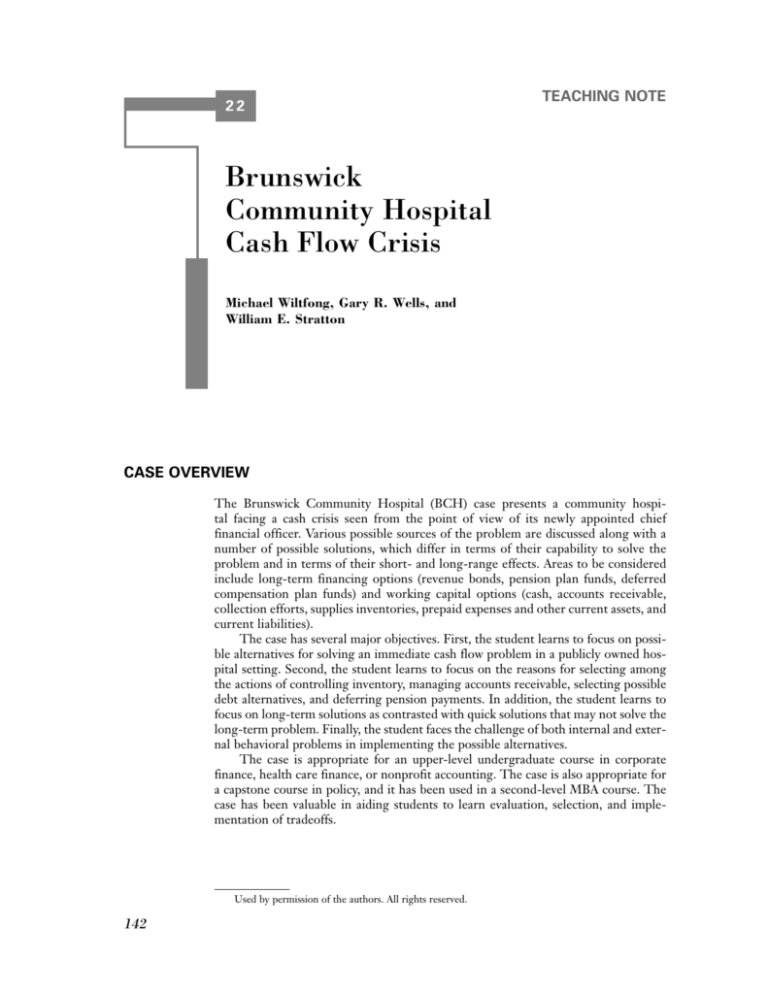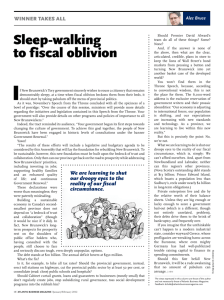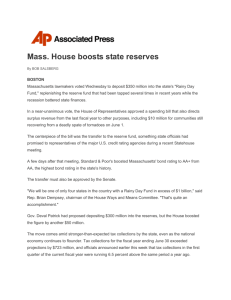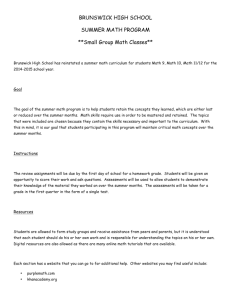
22
TEACHING NOTE
Brunswick
Community Hospital
Cash Flow Crisis
Michael Wiltfong, Gary R. Wells, and
William E. Stratton
CASE OVERVIEW
The Brunswick Community Hospital (BCH) case presents a community hospital facing a cash crisis seen from the point of view of its newly appointed chief
financial officer. Various possible sources of the problem are discussed along with a
number of possible solutions, which differ in terms of their capability to solve the
problem and in terms of their short- and long-range effects. Areas to be considered
include long-term financing options (revenue bonds, pension plan funds, deferred
compensation plan funds) and working capital options (cash, accounts receivable,
collection efforts, supplies inventories, prepaid expenses and other current assets, and
current liabilities).
The case has several major objectives. First, the student learns to focus on possible alternatives for solving an immediate cash flow problem in a publicly owned hospital setting. Second, the student learns to focus on the reasons for selecting among
the actions of controlling inventory, managing accounts receivable, selecting possible
debt alternatives, and deferring pension payments. In addition, the student learns to
focus on long-term solutions as contrasted with quick solutions that may not solve the
long-term problem. Finally, the student faces the challenge of both internal and external behavioral problems in implementing the possible alternatives.
The case is appropriate for an upper-level undergraduate course in corporate
finance, health care finance, or nonprofit accounting. The case is also appropriate for
a capstone course in policy, and it has been used in a second-level MBA course. The
case has been valuable in aiding students to learn evaluation, selection, and implementation of tradeoffs.
Used by permission of the authors. All rights reserved.
142
Brunswick Community Hospital
143
TEACHING OBJECTIVES
1.
Provide an exercise placing the student in a broad decision-making setting within
a public organization that is in a cash flow crisis.
2.
Establish a pattern of looking at the areas of largest possible gain from alternative decisions and to understand the differences between short-run and long-run
solutions.
3.
Understand the broader implications of decisions in a public setting and to combine sound financial principles with the reality of strategic choices.
QUESTIONS
1. How can Peter Butler determine the financial areas of concern in the case? Would common
size income statements and common size balance sheets be helpful?
First, Peter should examine the balance sheet and income statement to determine
changes in trends generally and changes from Year 3 to Year 4 in particular. Second,
Peter should examine the possibility of making major adjustments in areas of major
adverse change.
Peter can use the common size balance sheet (percent of total assets) and the
common size income statement (percent of sales or revenue) to gain insight. Changes
can serve as red flags that can lead to a better understanding of the problems.
[At the option of the instructor, students can be given the common statements
shown as Table TN-1 and Table TN-2 as handouts to supplement the case, or they
can be encouraged to generate their own tables.]
An examination of Table TN-1 indicates major changes in trends in patient
receivables and collections. Receivables have moved from 31.09% of assets in Year 3
to 36.29% in Year 4. Through a change in policy, collections written off have increased from 5.83% of assets to 17.14%.
An examination of Table TN-2 indicates major changes in professional care of
patients and fiscal and administrative services. In the past year, costs of professional care
of patients have increased from 64.39% of operating revenue to 78.64%. Fiscal and
administrative services have increased from 19.06% of operating revenue to 24.05%.
2. What are the implications of not funding the pension plan for 1 year?
Not funding the pension plan for 1 year would meet the shortfall. This appears to be
an easy solution. This solution, however, is only a temporary device. The problem will
recur unless a long-term solution is found. The employees may think such an action
is not ethical. This solution may result in dissatisfaction of the employees, lower performance, and higher costs resulting from inefficiency.
3. What factors are important in using a revenue bond for financing the needs?
The use of revenue bonds would provide a long-term source of financing. The case
points out, however, that similar bonds have failed recently in the community and that
the board of trustees opposes the idea. These bonds require substantial lead time
before funds are available. The solution is not a permanent solution to the problem if
the firm does not generate revenue to service the bond.
4. What items in inventory could be better controlled, and what are the financial
implications of these changes?
Inventory controls can be applied to the “nonlife-threatening” items based on past
usage patterns. The strict controls on “life-threatening” items are probably difficult
to implement.
144
Resource Utilization and Control
Table TN-1.
Brunswick Community Hospital common size balance sheet (at June 30)
ASSETS
Year 1
Year 2
Year 3
Year 4
Current Assets
0.71%
1.46%
0.82%
0.60%
Patient receivables
Cash & cash equivalents
28.02%
30.77%
31.09%
36.29%
Less: uncol. & allowances
⫺5.05%
⫺5.58%
⫺5.83%
⫺17.14%
Taxes receivable from county
0.46%
0.45%
0.43%
0.57%
Due from 3rd-party payers
0.00%
0.00%
1.11%
0.00%
Supplies & Inventory
2.25%
2.43%
2.34%
2.15%
Prepaid expenses
0.18%
0.24%
0.19%
0.36%
Total Current Assets
26.57%
29.77%
30.15%
22.83%
Investment & Other Assets
Interest-bearing deposits designated by
board for capital improvements
2.47%
3.14%
1.65%
0.43%
Investment in medical office building
3.02%
2.84%
2.44%
2.61%
Deferred financing costs
0.17%
0.11%
0.05%
0.00%
Deferred compensation plan
0.00%
0.00%
10.00%
13.51%
5.66%
6.09%
14.14%
16.55%
108.88%
110.16%
102.62%
120.20%
41.10%
46.02%
46.89%
59.58%
67.78%
64.14%
55.73%
60.62%
100.00%
100.00%
100.00%
100.00%
Unsecured notes payable to bank
0.00%
0.00%
1.03%
1.90%
Current maturities of long-term debt
1.72%
2.13%
1.42%
0.32%
Accounts payable
3.46%
2.94%
3.24%
4.86%
Due to third-party payers
0.42%
0.21%
0.00%
1.05%
Accrued expenses
3.01%
3.01%
3.14%
4.21%
8.61%
8.29%
8.83%
12.34%
Property & equipment at cost
Less accum. depreciation
Total Assets
Current Liabilities
Total Current Liabilities
Long-term debt less current maturities
3.55%
2.08%
0.51%
0.08%
Deferred compensation payable
0.00%
0.00%
10.00%
13.51%
87.83%
89.63%
80.66%
74.08%
100.00%
100.00%
100.00%
100.00%
Fund balance
Total Liabilities and Fund Balance
Based on the data in Table 5 of the case, the dollars involved in inventory are not
large enough to solve the problem. From a behavioral perspective, working on the
definition of “life-threatening” item would have a positive impact. These discussions,
however, would have to be in nonfinancial terms.
5. What strategies are possible for accounts receivable management?
Accounts receivable management is the area with the most potential. Based on case
information and data in Table 3 of the case, this area deserves the most attention. As
Brunswick Community Hospital
Table TN-2.
145
Brunswick Community Hospital common size income statement (year ended June 30)
REVENUE AND EXPENSES
Net Patient Service Revenue
Other Operating Revenue
Total Operating Revenue
Year 1
Year 2
Year 3
Year 4
99.54%
99.50%
99.94%
99.81%
0.46%
0.50%
0.06%
0.19%
100.00%
100.00%
100.00%
100.00%
Operating Expenses
Professional care of patients
64.61%
59.85%
64.39%
78.64%
General services
13.63%
12.31%
12.30%
14.39%
Fiscal and admin. services
21.33%
19.73%
19.06%
24.05%
7.94%
7.79%
7.69%
8.14%
Total operating expenses
107.51%
99.68%
103.44%
125.22%
Income from operations
⫺7.51%
0.32%
⫺3.44%
⫺25.22%
Property taxes
1.18%
1.11%
1.05%
2.48%
Income on interest-bearing deposit
for capital improvements
0.38%
0.07%
0.20%
0.11%
Operating funds
0.07%
0.08%
0.38%
0.20%
0.00%
⫺0.03%
⫺0.02%
0.00%
Depreciation
Nonoperating Gains (Losses)
Gain (Loss) on disposal of equip.
Unrestricted gifts and requests
0.03%
0.02%
0.22%
0.12%
Other
0.02%
⫺0.12%
⫺0.11%
⫺0.11%
Net nonoperating gains
Rev. & Gains in excess of exp.
1.68%
1.13%
1.72%
2.80%
⫺5.83%
1.45%
⫺1.72%
⫺22.42%
117.68%
106.43%
101.26%
109.78%
⫺5.83%
1.45%
⫺1.72%
⫺22.42%
0.12%
0.74%
0.03%
0.47%
111.97%
108.62%
99.57%
87.83%
CHANGES IN FUND BALANCE
Balance, Beginning
Rev. & gains in excess of exp.
Funds restricted for equipment purchases
Balance Ending
indicated in Table 3, $746,032 of patient receivables are 121 to 360 days outstanding,
and $466,754 of patient receivables are over 360 days. By implementing a strong collection strategy on these accounts, even minimal success could solve the problem.
Collection of less than 11% of the over 120 day accounts would solve the cash flow
problem for the next year.
Possible options include 1) implementing TQI (total quality improvement) techniques in the billing process to lower cycle times, 2) providing cash discounts to old
balances (discounts to old balances may cause insurers to react and ask for the same
discounts), and 3) setting forth specific changes in the over 120 day private pay
accounts to provide at least regular partial payments.
6. What behavioral problems might be encountered in rigid accounts receivable management
strategies?
Accounts receivable strategies should be implemented so that they do not adversely
impact the reputation of the hospital. Most states, including the state in which BCH
operates, have legislative mandates that require that a licensed hospital treat patients
146
Resource Utilization and Control
on an emergency basis regardless of ability to pay. These mandates have generally
been interpreted by the industry and public as a requirement that a hospital treat all
patients, emergency and nonemergency. Therefore, BCH, as well as most hospitals,
has a certain number of patients who do not expect to pay for services and believe it
is their right to receive these services. In other markets, tightening of collection procedures, such as requiring small payments (e.g., $10) at the time of service or requiring payment before performance of services, have resulted in vocal protest from the
community and/or filing of tort claims against hospitals.
7. What risk issues are involved in using the deferred compensation funds to meet immediate
cash needs?
Using the deferred compensation funds would force the participants to invest in one
industry—health care. The underlying investments in the fixed interest contracts are
more diversified. The participant’s risk is substantially higher without an increase in
return.
The funds are currently investments with an insurance company. Because of regulations, the underlying assets of the insurance company will be conservative and
diversified.
8. If you were Peter Butler, what actions would you take?
As Peter, I would examine the possibility of making major adjustments in the areas
indicated in the common statements (see Question 1). I would attack the problem of
receivables and collections quickly. I would train or hire persons to examine each of
the accounts. Persons associated with outstanding accounts often have unique characteristics and situations. Accounts should be examined for size (Is it large enough to
spend substantial effort on it?) and ability to pay versus desire to pay. Response letters
on accounts can provide insight. Although painstaking, accounts large enough to
merit the effort should be carefully scrutinized before eliminating them as being
uncollectible. Collections, as shown in the common income statement and the balance
sheet, offer the opportunity to solve the cash flow problem. The forecast in Table 2 of
the case shows a cash deficit of $125,000. The receivables and written off accounts
from Year 3 to Year 4 show a change of $790,779. People in the collections area need
to be motivated. As mentioned in Question 5, a success rate of just 11% on the
accounts over 120 days would cover the $125,000 cash flow need. Depending on
specifics, I would train, retrain, or replace persons in the area of collections.
I would examine the procedures for payment used when a patient comes into the
hospital. Emergency care may be difficult to handle, but scheduled health care services should require an approved payment program. This program should consider
primary insurance, any secondary policies, self-pay, or indigence. Programs for the
indigent should be established when possible with an approving agency (e.g., a religious or county institution, such as the local state mental hospital) with which the
patient is affiliated.
I would also scrutinize costs for professional care of patients and fiscal and
administrative services. Revenue dropped by more than 9% from Year 3 to Year 4, resulting in a decrease of $618,960. Fiscal and administrative service costs increased by
more than 14% from Year 3 to Year 4. The portions of fixed and variable costs need
to be considered. Can I reduce these costs without cutting quality? Can I question
administrative costs? Obviously, cutting personnel in the area of collections would be
a mistake. Patient days in both extended care and residential care dropped from Year
3 to Year 4, but only by a total of about 4.7%. During this same time period, however,
Medicaid and Medicare inpatient utilization rose from 44% to almost 50%, which
may further help explain the decrease in revenues (see Table TN-3).
Brunswick Community Hospital
147
Table TN-3. Brunswick Community Hospital comparison of growth in revenues and growth
in administrative services
Year
Year
Year
Year
Year
1
2
3
4
Revenues
Growth of
revenues
Fiscal and
administrative services
Growth of fiscal and
administrative services
$5,905,987
$6,212,724
$6,664,092
$6,045,132
5.19%
7.27%
⫺9.29%
$1,259,970
$1,225,901
$1,270,212
$1,453,754
⫺2.70%
3.61%
14.45%
EPILOGUE
Despite a significant decrease in activity, the hospital exceeded the Year 5 fiscal forecast by $75,000. The primary determinant was a change in the handling of private pay
accounts. The board adopted a policy that stated that accounts could be paid over a
period of time. The patient was required to make regular monthly payments. This
policy applied to both old and new accounts. Old accounts would continue without
interest charges. The interest charge for new accounts would be 18% APR. After
some initial efforts to reconstruct the history, the impracticality of determining the
status of many accounts became clear. The decision was made to treat all accounts as
collectible and to actively pursue collection. The contract accounts, as these accounts
became known, were removed from the active accounts receivable system. The hospital purchased a separate system designed to handle these monthly payment types of
accounts. After some initial negative media coverage, this system was well accepted.
In Fiscal Year 5, the positive estimated impact due to these changes was $480,000.
Neither the board of trustees nor management ever considered stopping the
funding of the pension or using deferred compensation funds to make up the shortfall. One day, in an employee meeting, a new senior manager incorrectly assumed the
hospital had an outside pension plan and communicated this assumption to the
employees as fact. Following the meeting, an employee contacted the pension administrator. In conjunction with the ensuing conversation, the administrator informed the
employee of the options discussed in this case and indicated that the manager’s comments had been incorrect. The employee thus became aware that the hospital had
periodically discontinued funding the pension plan. The resulting firestorm of employee protests should not have come as a surprise.
Instructor’s Manual for Cases in Health Services Management, fifth edition, by Rakich, Longest, and Darr.
Copyright © 2010, Rakich, Longest, and Darr.







